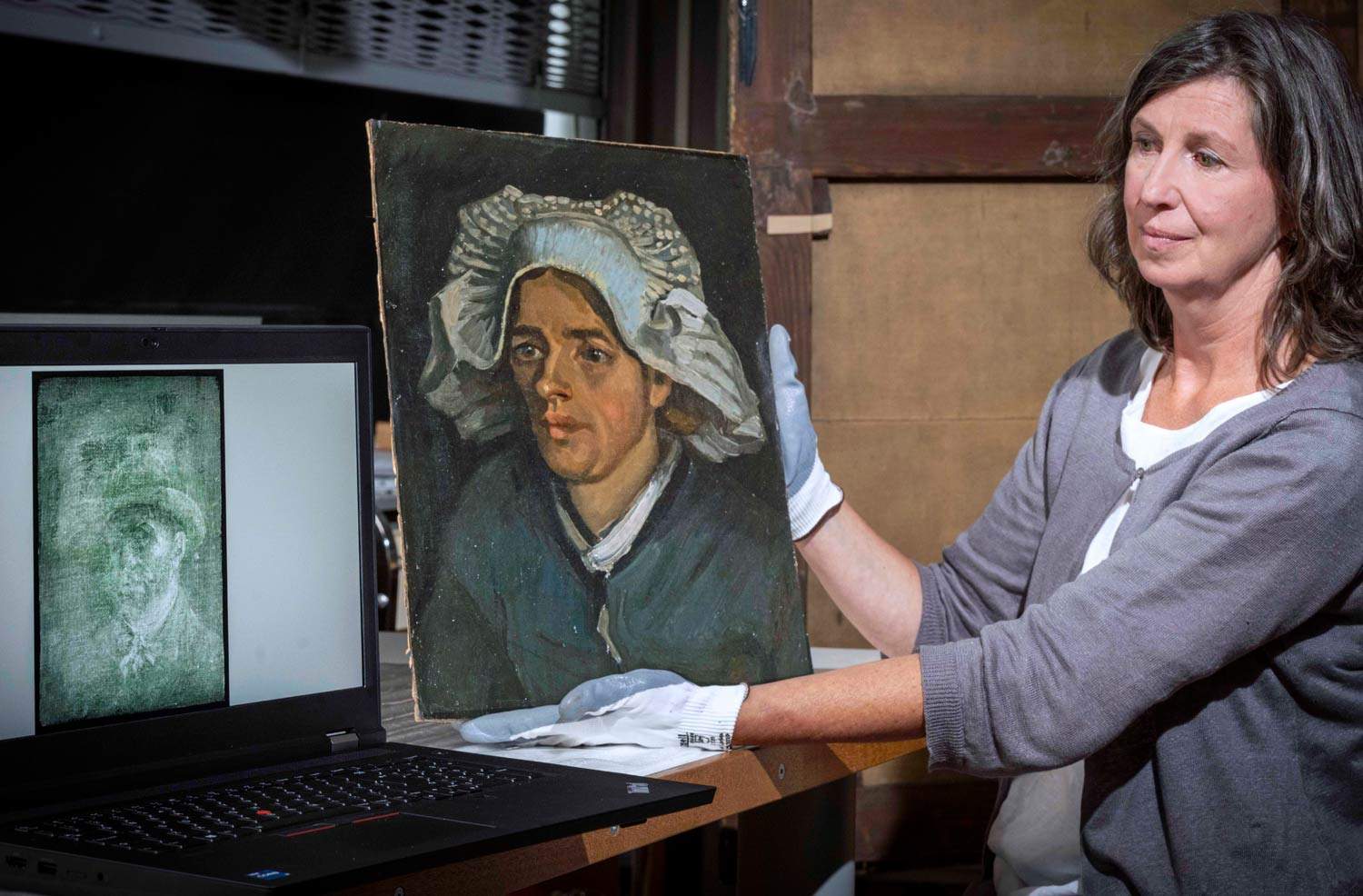A hidden self-portrait by Vincent van Gogh has been found at the National Galleries of Scotland in Edinburgh, a discovery described as “sensational” by the Scottish museum. It is a previously unknown work: the mysterious image was on the back of the Peasant’s Head painted in April 1885 in Neunen, which is kept at the Scottish museum. It was discovered thanks to an X-ray taken of the painting ahead of its loan for the A Taste for Impressionism exhibition scheduled July 30 to Nov. 13 at the Royal Scottish Academy in Edinburgh. Visitors will be able to see for the first time the extraordinary image uncovered with X-rays through a specially arranged lightbox in the Royal Scottish Academy’s exhibition itinerary.
Hidden from view for more than a century, the self-portrait is located on the back of the Peasant’s Head canvas and is covered with layers of glue and cardboard. Van Gogh often reused canvases to save money. However, instead of painting over earlier works, he would turn the canvas around and work on the reverse. According to experts at the National Galleries of Scotland, there would be a possibility of uncovering the self-portrait to expose it to view, but the process of removing the glue and cardboard will surely require delicate conservation work, and now the museum is trying to figure out how this can be achieved without damaging the Peasant’s Head.
The newly discovered work shows a bearded subject wearing a brimmed hat with a neckerchief tied around his throat. He stares at the viewer with an intense gaze, the right side of his face in shadow and his left ear clearly visible. The condition of the underlying self-portrait is unknown, since for now the image is known to us only from the X-ray: if it can be discovered, it will help shed new light on the artist. Later than the Peasant’s Head, the newly discovered self-portrait was probably made at a key moment in Van Gogh’s career, around the time of his move to Paris.



Professor Frances Fowle, Senior Curator of French Art at the National Galleries of Scotland, said, "Moments like this are incredibly rare. We have discovered an unknown work by Vincent van Gogh, one of the most important and popular artists in the world. What an incredible gift to Scotland! And it will forever be in the care of the National Galleries. We are very excited to share this exciting discovery in our major summer exhibition A Taste for Impressionism, where the X-ray image of the self-portrait will be visible to all."
Peasant’s Head entered the museum’s collection in Scotland’s capital city in 1960 as part of a donation from an Edinburgh lawyer, Alexander Maitland, in memory of his wife Rosalind. Dating from an early period in Van Gogh’s career, the painting shows a woman from the southern Dutch town of Nuenen, where the artist lived from December 1883 to November 1885. Painted in March or April 1885, it appears to bear a resemblance to Gordina de Groot (known as Sien), who posed for Van Gogh’s first masterpiece, The Potato Eaters of 1885 kept at the Van Gogh Museum in Amsterdam. His facial features, white headdress and simple work clothes are drawn in oils, using broad brushstrokes and earthy colors typical of French realist artists such as Jean-François Millet, whom Van Gogh greatly admired.
In 1886 the artist moved to Paris to be closer to his brother Theo, who was an early supporter of the Impressionists. Exposed to the work of this revolutionary group of artists, Van Gogh lightened his palette and experimented with a new language of broken brushstrokes. In Fernand Cormon’s studio, where he took painting lessons, he met avant-garde artists such as Henri de Toulouse-Lautrec and Emile Bernard. He also became acquainted with the work of Georges Seurat and Paul Gauguin, under whose influence he began to paint more expressively, using brighter colors. By the summer of 1887 Van Gogh was experimenting with portraits, using friends and even himself as a model. Theo was out of town and unable to help him financially, so Van Gogh reused his canvases to save money. Van Gogh died in 1890 and his brother followed six months later, at which point the artist’s entire oeuvre was left to Theo’s widow, Jo Van Gogh-Bonger.
Probably around 1905, when Peasant’s Head was loaned for an exhibition at the Stedelijk Museum in Amsterdam, the decision was made to paste the canvas on cardboard before framing it. By this date the Peasant Girl was evidently considered more “finished” than Van Gogh’s self-portrait. The painting changed hands several times and in 1923 was acquired by Evelyn St. Croix Fleming, whose son, Ian, became the celebrated author of the James Bond books. It was only in 1951 that it came to Scotland, having entered the collection of Alexander and Rosalind Maitland.
Hidden Self-Portrait is one of a group of many such self-portraits and other works painted on the back of earlier canvases from the Nuenen period. Five examples are in the Van Gogh Museum in Amsterdam. Others are in the Metropolitan Museum of Art in New York, the Wadsworth Atheneum Museum of Art, and the Kunstmuseum in The Hague. Van Gogh Museum documents finally confirm that in 1929 the cardboard was removed from three of the Nuenen period works by Dutch restorer Jan Cornelis Traas, revealing the portraits on the back.
 |
| Remarkable discovery in Scotland: unknown self-portrait of Vincent van Gogh found |
Warning: the translation into English of the original Italian article was created using automatic tools. We undertake to review all articles, but we do not guarantee the total absence of inaccuracies in the translation due to the program. You can find the original by clicking on the ITA button. If you find any mistake,please contact us.